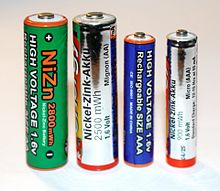Nickel-zinc accumulator
A nickel-zinc accumulator ( NiZn accumulator ) is an accumulator made from nickel and zinc .
history
Although this type of battery was patented by Thomas Alva Edison as early as 1901 , it was not until the 2000s that the zinc electrode was technologically stabilized to such an extent that this type of battery could be used in practice. The first nickel-zinc batteries only had a small number of charging cycles, as the zinc electrode lost its function due to passivation . In the 1960s, nickel-zinc batteries were considered as an alternative to silver-zinc batteries in military applications, but were rejected because of their low number of cycles.
As of the beginning of 2011, NiZn cells in the form of a mignon cell ( AA cell ) are available for general applications. The most interesting aspect is the voltage of around 1.6 V per cell, which is an advantage for devices that are designed for alkaline-manganese batteries and their 1.5 V. Conventional batteries in mignon cell form such as nickel-cadmium batteries (NiCd) or nickel-metal hydride batteries (NiMH) are cheaper, but only have a cell voltage of 1.2 V. Due to the different voltages, special chargers are also required for NiZn cells.
In the meantime, prismatic 12 V nickel-zinc batteries are also being manufactured and tested for use in hybrid vehicles .
The latest developments (as of 2016) are aimed at porous, sponge-like structures of the zinc anode. This prevented the formation of dendrites in the zinc and significantly increased the number of charging cycles.
Advantages and disadvantages compared to NiMh batteries
- advantages
- high tension
- High efficiency
- high performance
- high performance even after many cycles
- very good performance even in the cold
- low self-discharge in the first few months
- disadvantage
- lower capacity than high capacity NiMH batteries
- fewer cycles than Eneloop (Low Self-Discharge)
- very steep voltage drop towards the end of the capacity
- special charger required
- longer charging times thanks to the CC-CV charging process
- Price a little higher
Electrochemistry
For the discharge process, which goes with the arrow to the right, or the charging process with the arrow to the left, the reaction equation at the positive electrode, which supplies 0.49 V, is:
The nickel (III) oxide hydroxide takes up the electrons given off by the zinc and reacts with water to form nickel (II) hydroxide and hydroxide ions . The reaction equation at the negative electrode, which delivers 1.24 V, is:
Elemental zinc reacts with hydroxide ions , releasing electrons to form zinc hydroxide . The overall reaction results from:
In the charged state, zinc and nickel (III) oxide hydroxide with water are present on the electrodes . Zinc hydroxide and nickel (II) hydroxide occur in the discharged state .
The open circuit voltage after charging is 1.73 V, the end-of- charge voltage is around 1.90 V, the end-of-discharge voltage is around 1.2 V. The specific energy density is between 65 and 120 Wh / kg, which is roughly the same as for nickel-metal hydride batteries , but less than for lithium-ion batteries .
literature
- Dwaine Coates, Allen Charkey: Handbook of Batteries, Chapter 31 . Ed .: David Linden. 2nd Edition. McGraw-Hill, 2002, ISBN 978-0-07-135978-8 .
Individual evidence
- ↑ Patent US684204 : Reversible Galvanic Battery. Registered October 31, 1900 , published October 8, 1901 , inventor: Thomas Alva Edison.
- ^ A Brief History of Battery Developments , accessed on February 9, 2011.
- ^ The nickel-zinc battery , elektroniknet.de, May 28, 2013.
- ↑ Light and powerful: the nickel-zinc battery is intended to replace standard models. In: Spiegel Online . April 28, 2017. Retrieved October 12, 2017 .
- ↑ Joseph F. Parker, Christopher N. Chervin, Irina R. Pala, Meinrad Machler, Michael F. Burz, Jeffrey W. Long, Debra R. Rolison : Rechargeable nickel – 3D zinc batteries: An energy-dense, safer alternative to lithium -ion . In: Science . tape 356 , no. 6336 , 2017, p. 415-418 , doi : 10.1126 / science.aak9991 .
- ↑ NiZn: Nickel-zinc batteries as an alternative? pocketnavigation.de
- ↑ Peter Birke, Michael Schiemann: Accumulators: Past, Present and Future of Electrochemical Energy Storage . 2013, p. 167 .
- ↑ The nickel-zinc battery , elektroniknet.de, May 28, 2013, part 2.




